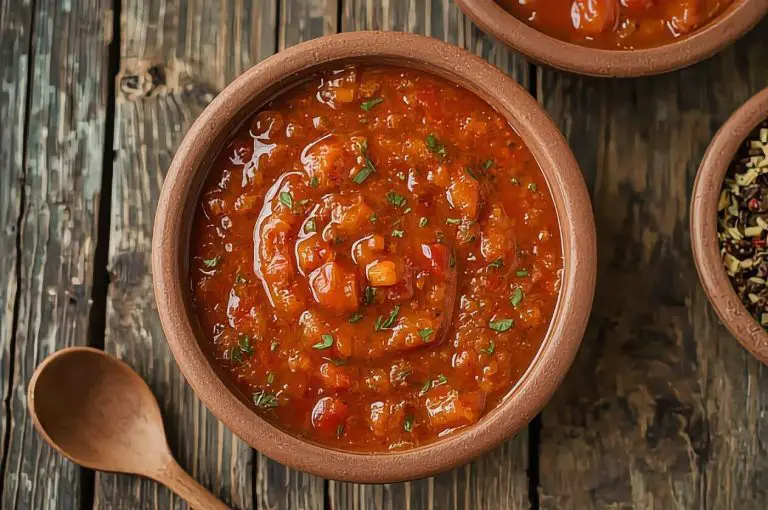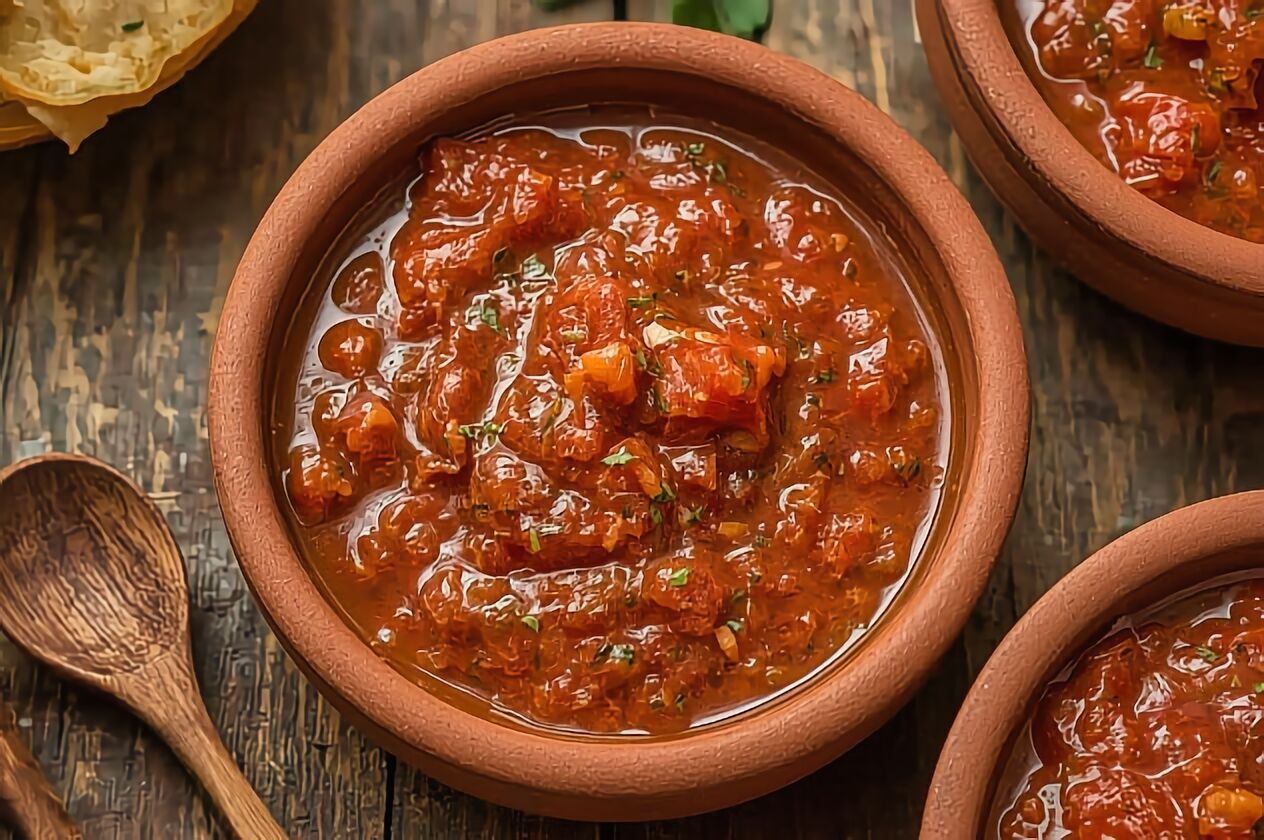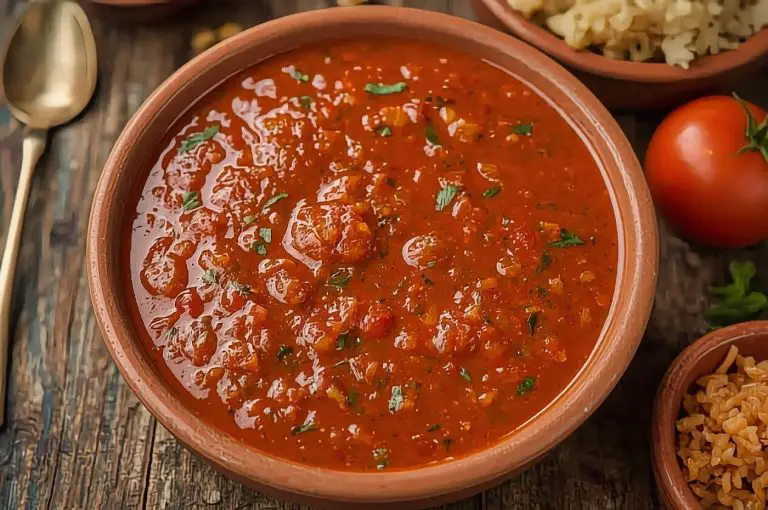The Bolivian Llaajwa Recipe is that spicy Bolivian sauce you’ll find on just about every table in Bolivia—seriously, it’s everywhere. It’s a fresh, punchy blend of peppers, tomatoes, and herbs that somehow manages to go with almost any meal, whether it’s grilled meats, roasted veggies, or just some bread. What really sets Llajwa apart, though, are those local touches: the fiery locoto pepper and the herb quirquiña. You won’t get that exact flavor combo anywhere else.
On our travels through Bolivia, we noticed folks whip up Llajwa fresh every day, slathering it on food like it’s ketchup. Every region, even every household, seems to have its own way of making it. That’s part of what makes it such a vibrant piece of Bolivian cuisine. Sharing this recipe just feels like passing along a little slice of Bolivia.
Key Takeways
- Llajwa is a staple spicy sauce in Bolivian cuisine made with simple, fresh ingredients.
- The recipe is quick to prepare and enhances many dishes.
- Regional variations make Llajwa a versatile and essential Bolivian condiment.

Bolivian Llaajwa Recipe Ingredients
Servings: 8
Prep Time: 20 Minutes
Cooking Time: 10 Minutes
4 tomatoes
2 habanero, or locoto peppers
2 jalapeños, green
2 tbsp onion, chopped
2 tbsp cilantro, chopped Bolivian (quirquiña)
1½ tsp basil, fresh (optional)
2 tsp olive oil
1/4 tsp salt to taste
1/4 tsp sugar, (optional)
Bolivian Llaajwa Recipe Cooking Instructions
Start by getting your fresh ingredients ready. Grab those ripe tomatoes and spicy peppers—locoto or jalapeño work great. Chop the tomatoes into chunks, halve the peppers, and if you like things hot, leave the seeds in.
Traditionally, Bolivians grind everything together using a batan (think giant flat mortar and pestle). That method keeps the flavors bright and prevents the sauce from overheating. Don’t have a batan? No worries. A food processor or blender works, just don’t go overboard—pulse it so it stays a little chunky.
Toss in a handful of fresh herbs like cilantro or, if you’re lucky, quirquiña. Chop those up and mix with your tomatoes and peppers. Salt to taste.
If you want, add some finely chopped onion at the end—Vidalia is a good pick for its sweetness. We usually stir it in only if we’re eating the Llajwa the same day.
Here’s a tip: when you blend the tomatoes, set aside the seeds and mix them back in at the end. It adds a bit of texture and a nice tomato punch.
All in all, you’re looking at about 10 minutes for this part. You’ll end up with a sauce that’s fresh, vibrant, and ready to go.

Bolivian Llaajwa Recipe
Ingredients
- 4 tomatoes
- 2 habanero or locoto peppers
- 2 jalapeños green
- 2 tbsp onion chopped
- 2 tbsp cilantro chopped Bolivian (quirquiña)
- 1½ tsp basil fresh (optional)
- 2 tsp olive oil
- 1/4 tsp salt to taste
- 1/4 tsp sugar (optional)
Instructions
- Start by getting your fresh ingredients ready. Grab those ripe tomatoes and spicy peppers—locoto or jalapeño work great. Chop the tomatoes into chunks, halve the peppers, and if you like things hot, leave the seeds in.
- Traditionally, Bolivians grind everything together using a batan (think giant flat mortar and pestle). That method keeps the flavors bright and prevents the sauce from overheating. Don’t have a batan? No worries. A food processor or blender works, just don’t go overboard—pulse it so it stays a little chunky.
- Toss in a handful of fresh herbs like cilantro or, if you’re lucky, quirquiña. Chop those up and mix with your tomatoes and peppers. Salt to taste.
- If you want, add some finely chopped onion at the end—Vidalia is a good pick for its sweetness. We usually stir it in only if we’re eating the Llajwa the same day.
- Here’s a tip: when you blend the tomatoes, set aside the seeds and mix them back in at the end. It adds a bit of texture and a nice tomato punch.
- All in all, you’re looking at about 10 minutes for this part. You’ll end up with a sauce that’s fresh, vibrant, and ready to go.
Notes
Cooking Tips
Honestly, the fresher your ingredients, the better your Llajwa will taste. Ripe tomatoes and fresh peppers make a world of difference. We’ll use locoto peppers when we can find them, but green jalapeños are a solid backup. Like it fiery? Keep those seeds. Prefer a milder kick? Take ‘em out.
The old-school batan method is still our favorite. Grinding by hand keeps the sauce textured, not mushy. But if you’re short on time or tools, a food processor is just fine—just pulse, don’t puree.
Go easy on the salt at first; you can always add more at the end. Chopped onions (especially Vidalia) are a nice touch, but only add them if you’re planning to eat the sauce fresh. Llajwa doesn’t love to sit around—its flavor fades fast.
Serve it with grilled meats, boiled veggies, or classic Bolivian dishes like salteñas. It’s one of those sauces that makes everything better, but it’s really at its best right after you make it.
Bolivian Llaajwa Recipe FAQs
The Bolivian Llaajwa Recipe keeps it simple with just a handful of ingredients, but every region and family does it a little differently. The name might trip you up, and there are a few versions depending on which peppers you use. It goes with all sorts of Bolivian meals, and you can easily make it at home—even with vegan tweaks.
What are the essential ingredients for a traditional Bolivian Llaajwa Recipe?
You’ll need tomatoes, locoto peppers, salt, and fresh herbs like quillquiña or cilantro for the Bolivian Llaajwa Recipe. Some folks toss in onions (Vidalia is a favorite) for a little extra flavor. The peppers bring the heat.
How do you properly pronounce ‘llajwa’ when referring to the Bolivian sauce?
Say it like “yah-hwa.” The double “ll” in Spanish sounds like a soft “y,” and you pronounce “wa” clearly at the end—so, “yah-hwa.”
Is there a difference between green llajwa and other varieties of the Bolivian Llaajwa recipe?
Definitely. Green llajwa typically uses green peppers like locoto and sometimes green herbs like quillquiña. Other versions swap in red tomatoes or different peppers, which changes up both the flavor and the color of the Bolivian Llaajwa recipe.
What are some common dishes that this Bolivian Llaajwa recipe is typically served with?
You’ll see the Bolivian Llaajwa recipe with almost every meal. It’s great with grilled meats, potatoes, rice, corn, and even soups. Basically, if it’s on the table, Llajwa probably is too.
Can you provide a step-by-step guide for making the authentic Bolivian Llaajwa recipe at home?
Chop up tomatoes and a couple of locoto peppers. Add fresh herbs like cilantro or quillquiña and a bit of salt. Grind or blend until you’ve got small pieces—add onion if you want. Adjust the heat by keeping or removing pepper seeds. Serve your Bolivian Llaajwa recipe right away.
Are there vegan-friendly adaptations of the classic Bolivian Llaajwa recipe?
Absolutely! Traditional Bolivian Llaajwa recipe already fits a vegan lifestyle because it’s just veggies, herbs, and a bit of salt—nothing animal-based sneaks in. As long as you stick with fresh ingredients and skip any odd non-vegan additions, you’re good to go. Honestly, it’s one of those rare classics that doesn’t need much tweaking for plant-based eaters.

